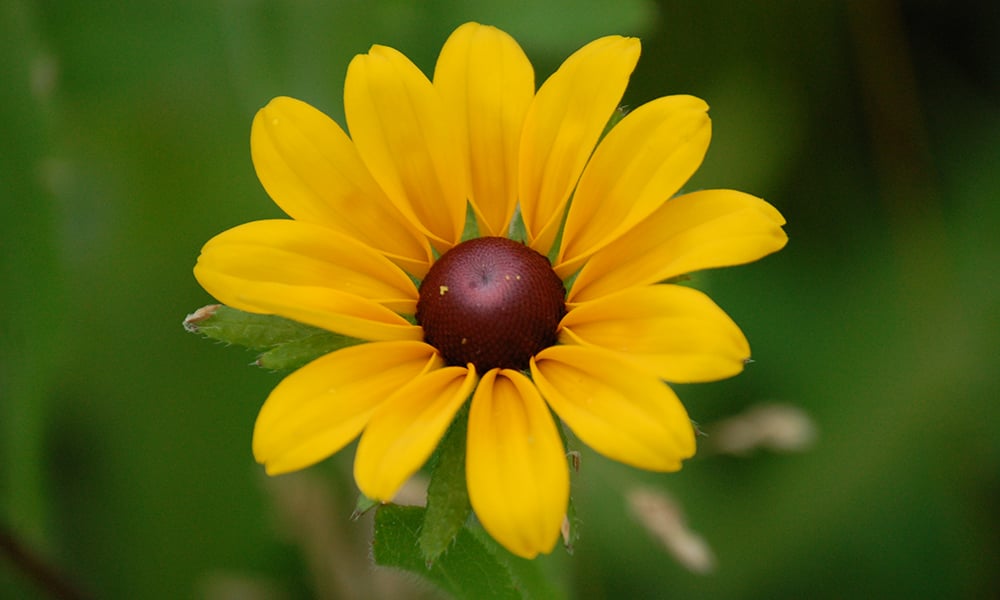
The relationship between milkweed and monarchs is well known and well documented. Monarch butterflies feed on the nectar in milkweed flowers, collecting pollen before transferring that pollen to another plant. Female monarchs also lay their eggs one at a time on the leaves of milkweed plants. When the eggs hatch, the larva are dependent on the milkweed for food.
The world of native plants is full of different kinds of symbiotic relationships like this. Some, like monarchs and milkweeds, are happy and relatively balanced with both insect and plant benefitting from one another. Others feature predators and parasites, using the native plants in a much more sinister way. Let’s consider one of the most beautiful and wonderful native plants: black-eyed susans.
Black-eyed susan (Rudbeckia hirta) plays host to a complicated web of interactions and relationships. To human eyes, the bloom of a black-eyed susan is a bright, cheerful yellow. But to bees, which see in the ultraviolet spectrum, the blooms of black-eyed susans reflect and absorb UV light so that the flower looks like a dark circle surrounded by a bright ring on the outer parts of the petals. This directs bees to the center of the flower, where they are rewarded with sweet nectar.

Black-eyed susan, Rudbeckia hirta.
Like the monarch and milkweed, the bees will often become covered in pollen. Some bee species, like the mining bee, is after the flower’s pollen and will use it to fill nesting cavities to feed their larvae. The small wavy-lined emerald moth will use black-eyed susans as a host plant. Their caterpillars will use leaf and petal cuttings from the flower to decorate their backs and help hide them while they feed and grow on the plant — and for good reason.
Predator wasps such as bee wolves and thread-waisted wasps lurk among these pollinators and growing larvae. Native bee species aren’t the only ones interested in the nectar of black-eyed susans. These native wasps are also hunting for sweat bees and smaller wasps to bring to their nest cavities. Jagged ambush bugs also may lie in wait for bees, flies, aphids and other soft-bodied insects that come to drink nectar at these plants.
In addition to these direct predators, black-eyed susans also attract parasitic insects like blister beetles, which lay their eggs on the flowers. When the larva hatches, it attaches itself to a bee and is carried back to the next, where is enters a brood cell, eats the egg, then polishes off the provisions left called bee bread. Bee flies are also frequent visitors, eating both nectar and pollen before finding nest sites of host insects like grasshoppers, moths, and flies to drop an egg into.
All of these symbiotic relationships center on the black-eyed susan. Now imagine a black-eyed susan being planted in a garden with wild bergamot, butterfly milkweed and fragrant (anise) hyssop, each of which have their own complicated set of relationships. These intricate systems — supported by a handful of plants — can provide a thriving habitat for a wide array of native insects. Imagine the countless birds, mammals and reptiles that could also benefit from this ecosystem. A few native plants can have an amazing impact on the diversity and health of your neighborhood.
Go Native in Your Garden!
Once you've mapped out your native landscaping, you can shop in person for native flowers, shrubs and trees at our annual Native Plant Sale at Mayslake Peabody Estate in Oak Brook.
Support the Friends of the Forest Preserve District of DuPage County and purchase a ticket to an exclusive Native Plant Pre-Sale.
This year's sale will be in-person only. Details, including a list of plants and info on tickets for the pre-sale, are available at dupageforest.org/native-plant-sale.

Native plants can attract pollinators like butterflies to backyards.